
Gili Islands
( 1 user review )The Gili Islands are located just off the northwest tip of Lombok, Indonesia.
Understand
Lombok's most popular tourist destination, the Gili Islands (or just the Gilis) came to the attention of the wider world as a backpacker mecca in the 1980s and 1990s. This is still true to some extent, and the islands are still a fixture on the Banana Pancake Trail. But the times they are a changing, and there is now a rash of glamour options on the islands, especially so on Gili Trawangan. The islands are very relaxed and laid-back, with countless little beachside cafes still playing reggae and serving up questionable "energy" drinks, but also at the other end of the scale, elaborate seafood buffets, fresh salads and good quality western and Asian food. Best of all, there are no cars or motorbikes to disturb the peace.
There are increasing numbers of westerners living on the Gilis, and operating businesses ranging from dive companies to resorts. There is a strong environmental focus here as the reefs have been very damaged in the past. While once people came to dive, snorkel and party, a more upmarket tourist is showing up now. It is still all about the beach, there are many more options to wine and dine or hang out and meet new friends.
Strictly speaking, the name "Gili Islands" is rather redundant as gili simply means "small island" in Sasak, but the name has stuck and is universally used and understood in Lombok.
There are also some other islands off Lombok called Gili Something, eg. Gili Nanggu and Gili Gede, but these are located to the southwest near Lembar, quite a distance from the "main" Gilis.
Climate
The Gilis are noticeably drier and hotter than Lombok, but evenings can still be cool and refreshing. The rainy season is roughly from November to April, but it rains much less than on Bali. The peak tourist seasons are July-August and December-January.
Regions
- Gili Trawangan - The largest and most visited of the three islands. Known as the party island.
- Gili Air - The closest of the three islands to Lombok, and the one with a well developed local community.
- Gili Meno - Sandwiched between the other two better known islands, Gili Meno is very laid back indeed.
Getting there
By plane
There are no airports in the Gilis. The nearest is at Mataram on mainland Lombok, but flying to Bali and taking a boat to the Gilis is also a viable option.
Alternatively, you can fly to Bali and connect onward with a domestic flight to Mataram, which is a quick and cheap 20-minute hop. The Bali-Mataram route is operated by Merpati Nusantara Airlines, Garuda, Trigana Air and the tiny regional carrier IAT.
From elsewhere in Indonesia, Mataram is served by flights from Jakarta and Surabaya.
From Bali
There are now a number of direct boat services from Bali to the Gilis, all of which continue onto the main island of Lombok. The fastest services depart from Benoa in South Bali, as this avoids a long road trip up to Padang Bai. Benoa Harbour is around 20 minutes from the main tourist areas in South Bali, whereas Padang Bai can take up to two hours by road. It's quicker to depart from Padang Bai if you are starting from central or east Bali, such as Ubud and Candidasa, or the east coast dive areas at Amed and Tulamben.
A daily speedboat service called Amed Sea Fast Boat started to ply the Amed to Gili Trawangan route in 2010. There is also a daily fast boat service to Gili Trawangan from Nusa Lembongan, a small island off the south east coast of Bali.
If you have more time than money, you can use a tour service (160,000 from Kuta/Ubud) to take you from your hotel on Bail, drop you off at the ferry, then pick you up in Lombok and switch cars a few times, then drop you off at the dock to the Gili's and then on to a small boat. The whole trip takes about 12 hours and you will be subjected to unnecessary hard sells on booking return tickets (not necessary). The last stop you may be befriended by those talking up stories of mosquito born illness, then try to be sold repellent and coils at extortionate prices. These products are reasonably priced on the Gili's
From Lombok
There are essentially two ways to get from Lombok to the Gilis: a shuttle bus or taxi to Bangsal (1 hr), and a public boat from there (15/30/45 min to Air/Meno/Trawangan) or direct privately chartered boats from Senggigi (1-2 hrs) or Teluk Nare (30 minutes).
The easiest way to get to the Gilis from Lombok's airport or Senggigi is to walk to the nearest travel agent, taxi desk or tout and book a package.
The cheapest way is to take a bemo/taxi to Pemenang, walk or cidomo to Bangsal, and then take the public ferry from there. However, this may involve long waits and dealing with a truly unpleasant bunch of touts, so some people figure it's not worth the hassle; see Bangsal for details.
If you want to travel at your own pace, you can charter a boat directly from Senggigi to take you across. Ask any travel agent or simply head to the beach behind the Santosa Hotel, where you're guaranteed to be solicited by boat operators. A charter of a regular outrigger (perahu) to any of the Gili Islands can cost as much Rp 500,000, but bargain hard. If there are three or less of you, it is much faster and infinitely more comfortable to arrange a speed boat pickup from Teluk Nare with one of the dive shops or your hotel on Gili Trawangan. A taxi to Teluk Nare form Senggigi will cost about Rp 30,000.
For organising your trip back, there is a public boat ticket office on each of the Gili Islands.
Note that the sea is calmest in the morning and all transport stops running in the mid afternoon, well before dark. During periods of southerly winds and in July and August especially, the swell can be a bit hairy and you are very likely to get wet on the crossing. It is advisable to place laptops, cameras and handphones in waterproof bags for the crossing.
Traveling around
In a rare display of foresight, all forms of motorized transport are banned from the islands: your only choice is horse-drawn carts, known as cidomo, which are used even to shuttle around diving gear. The price for visitors is Rp 20,000-30,000 per head for any trip, although it varies per island and per season. However, as the islands are only a few km in diameter, it's entirely possible to just walk instead.
Bikes are available for rent and the main tracks are good enough for riding, at least on Gili Trawangan.
Traveling between the islands requires either catching the infrequent scheduled public shuttle boats, or chartering one to take you across. You can buy tickets from the ticket offices on each island from where the boats depart. Booking through a travel agent just costs more, and you still need to change the reservation to an actual ticket at the very same counter.
The distances between the islands may seem swimmable, but do not attempt it — the currents are fierce and several foolish visitors have died trying.
See
There are no A grade sights as such on the islands, but the snorkeling and diving all around is a major draw.
Things to do
Scuba diving
There is reasonably good diving here, and the islands are globally known as a teaching centre. An impressive array of sea creatures and plant life is to be seen, such as green and hawksbill turtles, manta rays (rarely), bumphead parrotfish, black-tip and white-tip reef sharks, and more. Visibility is commonly in the 15-20m range. However, due to the exposed position of the Gilis, currents can be quite strong and drift diving is the norm.
Gili Trawangan has the most dive operators, but PADI and SSI licensed dive operators exist on all three islands. Equipment is kept in top shape, with excellent facilities and (mostly) western dive instructors. Divemasters are more commonly experienced locals. Dive and course prices are fixed by agreement between the dive operators on each island, so there is nothing financial to be gained by shopping around between the operators. A good approach is to settle down on your chosen island, get to know the dive shops, and chose to dive with the one with which you feel most comfortable.
For those interested in learning to dive or advancing existing qualifications, several of the operators now offer both PADI and SSI options. SSI is generally a little cheaper than PADI; talk to your chosen operator to find out which suits you best. Nitrox and other technical diving options are also offered by operators on Gili Trawangan especially.
All dive shops on the Gili Islands are members of the Gili Eco Trust , a non-profit organisation set up to protect coral reefs surrounding the islands and provide environmental education. There is a one time only reef tax of Rp 50,000 payable by all divers and dive students. This is collected by the dive operator and it is this reef tax that funds the work of the trust. If you are interested in learning more about the work of the trust, or volunteering to help, ask for Delphine at the Big Bubble dive shop on Gili Trawangan.
Dive Prices
-
Fun Dives: US$40.
-
PADI courses: Fun dives $US40, Discover Scuba US$60, Open Water US$350, Advanced Open Water US$275.
-
SSI courses: about 10% cheaper than the PADI equivalent. Check at dive shops.
All dive shops accept US dollar and rupiah cash as well as credit cards, except when the telephone lines are down (in this case, pay using internet banking).
Snorkeling
You can rent masks and fins off the beach, or contact any of the numerous dive shops to arrange snorkeling at choice spots nearby. A daily snorkeling programme usually involves a 10AM departure and 4PM return, and includes three or four spots around the three islands and a two-hour lunch break. The cost ranges from Rp 60,000 to 150,000 depending on the shop and your negotiating skills and includes fins, mask and snorkel, but not the cost of lunch.
It's possible to snorkel off some of the beaches, but pay attention to the currents, which can be strong even near the shore. Wear flippers even if you're a strong swimmer, or you'll spend most of your energy fighting the ocean.
Surfing
In the local marine stakes, surfing is a distant third to diving and snorkeling.
Relax
One of the attractions of the islands is the ability to do nothing. With no cars on any of the islands and the lower tempo of Gili Air and Gili Meno, there are several bungalow-style accommodations with verandas that overlook gardens of the ocean. The styles of cafes and restaurants involves small open huts perfect for two to four people to claim for a good part of the day. With a good book and your swimsuit, the day passes quickly when you leave your watch in your bag. The beaches are not exceptional. Gili Meno has the nicest beaches of the three islands. Gili Meno and Air have their best beaches on the west side of the islands. The south side tends to be windy and rough and the north and east have a lot of coral on the beaches, making the sand rough. On Gili Air, the only pleasant beach for swimming is really in front of the Chill-out cafe and Sunrise Hotel on the main strip.
Walk
The perimeters of all three islands are conducive to a 90 minute to three hour leisurely walk with no strenuous hills. Just follow the coastline, put on your sunscreen and it makes for a nice morning.
Eat
All the islands feature a myriad of restaurants and cafes concentrated on the beaches. The east sides of all the islands have the most activity. The majority are small cafes with decent food oriented toward tourists in small open huts. Featured food is usually barbecued fish or pizza from a wood-fired oven.
Drink
Gili Trawangan has a huge reputation as a party island, and whilst the scene has calmed down somewhat in recent years, there are many bars and something is happening almost every night of the year.
Sleep
Demand often outstrips supply, so prices tend to be noticeably higher than on Bali or Lombok. During the peak seasons (Jul-Aug, Dec-Jan), it pays to make advance reservations, as the best places are often fully booked. Arrive early for better chances of getting accommodation without a reservation. Late arrivers need to be prepared to spend a night on the beach (it's perfectly safe though).
There are plenty of largely identical backpacker guesthouses on the islands. The price ranges depending on the season and island. Figure on Rp 100,000+ for a basic room with fan only. Air conditioned rooms are more in the Rp 300,000-400,000+ range. Gili Trawangan especially, has a rapidly increasing range of high end accommodation with prices up to US$500 per night.
Always try to negotiate for the best price, and be clear about whether or not the quoted price includes taxes and breakfast. Some hotels feature fresh water for showering and others use salt water. Much of the so-called fresh water still has a high saline content, so it is hard to feel really clean after a few days. Some of the higher end places on Gili Trawangan have reverse osmosis desalination systems, and provide top quality fresh water.
Buy
There is an ATM on Gili Trawangan, but that's it. Exchange rates offered by moneychangers are noticeably poorer than on the mainland. Credit cards are accepted by some of the more upmarket places and all dive shops; some will also arrange credit card advances, but with hefty fees in the order of 7-10%.
Shopping opportunities are very limited. There are plenty of kiosks offering tourist staples such as drinks, basic cosmetics, suntan lotion and such, but anything even remotely unusual is best brought with you.
Etiquette
The Gilis may feel like Bali at times but the locals are Muslim, and while they are used to the endless parade of westerners partying on their front lawn, it is good to show some respect.Never sunbathe nude or topless, cover up away from the beach (no bikinis), avoid excessive displays of affection in public, and treat early-morning prayer calls from the mosque as just part of the local character.
Little changes on the Gili Islands during the fasting month of Ramadan, as food is served during the day and bars stay open at night. However, many dive shops cut down the diving schedule to cater for fasting locals, and out of respect you should also refrain from blatantly eating, drinking or smoking in public.
Stay healthy
All three islands have a small, simple clinic. For serious problems, visitors should get back to Lombok (or preferably Bali) as quickly as possible.
Tap water is very salty and not potable. Bottled water is widely available and many cafes, dive shops, and stores will fill up bottles for Rp 3,000, reducing waste and costing less than a new bottle, although many seem to be out of water constantly.
There are many self-styled gigolos anxious to swoon foreign girls on Gili Trawangan and Gili Air. If you're female and on your own (even temporarily), you will be approached often. If you find yourself swept off your feet, condoms are available at most little stores.
Thanks to the islands' dryness, mosquitoes are quite rare, but there have been a few cases of malaria and dengue reported, mostly during the rainy season. Mosquito repellent, mosquito nets and long sleeves at dusk are wise precautions.
Safety
True to the hippie vibe, magic mushrooms are widely available and openly advertised, particularly on Gili Trawangan. Their legality is questionable, as are any physical and psychological effects.
Various other drugs and intoxicants are readily available and sometimes flaunted (as is the case of mushrooms and 'power drinks' at parties), and you can expect to be offered everything from marijuana to methamphetamine. Keep in mind you are still in Indonesia, where drug usage and distribution penalties are extraordinarily harsh ranging from 20 years in a dilapidated prison to the death penalty. On Gili Trawangan there have been a number of busts of high profile local characters resulting in serious prison sentences. On Gili Air, village leaders have been known to banish tourists from the island for drug usage and several signs posted around the island will remind you of their local laws.
Small but annoying jellyfish are common in the waters around the Gilis during certain moon cycles, with July and August getting the brunt, so wearing a full-length wetsuit or surf skin in the water is advisable. The stings can be quite painful but they're harmless and usually go away within an hour. The welt from bad multiple stings may last a day.
There are massive spiders roughly the size of a grown man's hand scattered about the islands; while not venomous, their bites can result in a painful wound. Thankfully, avoiding them is relatively easy, don't tread through brush and avoid climbing random trees.
There are no police on any of the islands. Crime is largely limited to opportunistic petty theft, and all problems are usually settled by the local islands councils; if you face larger problems or need to make a police report for insurance purposes, you will need to head over to Mataram to do it.
Cope
The islands have no supplies of fresh water and very spotty electricity supply; it's not uncommon for power to be off for hours at a time, and same goes for water. Most upmarket hotels, restaurants and dive shops have generators, and there are tentative plans for solar and wind power generation.
Laundry can be arranged through most guesthouses, expect to pay by piece rather than by load. The cost can add up quick, you may want to consider hand-washing smaller items yourself, clothes dry very quickly in the equatorial sun.
Contact
Mobile phone towers ensure you're never out of touch. Telekomsel's Simpati SIM card has the strongest and most reliable coverage on the Gili islands. Internet cafes are quite widespread but connections often very slow.
There is no post office on the Gilis, but William's Bookshop, right behind the Art Market on Gili Trawangan, sells stamps and can mail out your postcards.
Get out
-
Bali — the Magical Island
-
Lombok — the perennial Bali 2.0
-
Sumbawa — one more island down the chain
Contact & location
1 Review
Add your review
The photos displayed on this page are the property of one of the following authors:
name_674, name_22064, name_23978, name_6716
Some photos courtesy of:
 . The photos provided by Flickr are under the copyright of their owners.
. The photos provided by Flickr are under the copyright of their owners.
This travel guide also includes text from Wikitravel articles, all available at  View full credits
View full credits
jan, Claus Hansen, Jani Patokallio, Phil Smith, mark_stockham@bluebottle.com, Jeremy, Seb Ruiz, David, Felicity T, Evan Prodromou, Handhika Wicaksana, Michelle Ong and sixzilly, Burmesedays, Balibound, Whatsinaname, Globe-trotter, Nequam, Morph, Pamoja and Jonboy
This travel guide also includes text from Wikipedia articles, all available at  View full credits
View full credits

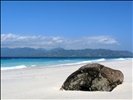
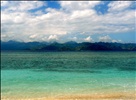
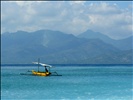

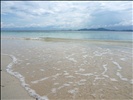
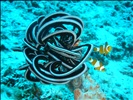


I liked
Much is accurate, but I lived there on and off from June 2010 until Jan. 2011 and have some comments below.I disliked
I wouldn't say it's PERFECTLY safe to sleep on the beach. Not for single females and not if you have a bag of belongings. There have been cases of drug-induced rape. Hardcore partiers will be very disappointed during Ramadan as there are no late parties and most everything closes down by midnight. I don't know when this was written, but there are now quite a number of clothing shops including surfwear and even vintage. There are a couple very upscale clothing stores with another on the way with a coffee shop attached. You will be surprised how much you can find if you just know where to look. Alfia offers computer parts like USB modems, and you can buy phones new or used on Trawangan. Several grocers offer imported good like spaghetti sauce, cheese and yogurt. You can have birthday cakes ordered from Ocean Dua or more upscale places.